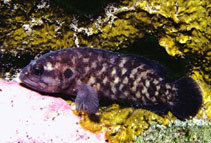| Family: |
Grammistidae (Soapfishes) |
| Max. size: |
6.1 cm SL (male/unsexed) |
| Environment: |
reef-associated; marine; depth range 15 - 100 m |
| Distribution: |
Eastern Pacific: Clipperton Islands. |
| Diagnosis: |
Dorsal spines (total): 6-7; Dorsal soft rays (total): 20-22; Anal spines: 3-3; Anal soft rays: 17-18; Vertebrae: 26-26. Live specimens brown, including fins; body covered with numerous large tan blotches. Upper part of operculum with a prominent eye-sized ocellated dark brown spot; two dark brown lines radiating backward from lower half of eye across the cheek, and a vertical white bar below the eye. Lateral line scales + 4-23 when counting pored as well as the tubed scales. Longitudinal scale series 49-51. A short, broad-based, triangular, dermal flap dorsally on eye. A large pore in interorbital space on each side close to the edge of the orbit; a small median pore posterior in interorbital space. Tubular anterior nostril when laid back reach slightly more than half distance to posterior nostril. |
| Biology: |
A cryptic species found in crevices and caves on the outer reef slope at 15-30 m; collected with rotenone (Ref. 81033). Minimum depth from Ref. 58018. |
| IUCN Red List Status: |
Near Threatened (NT); Date assessed: 03 May 2008 Ref. (130435)
|
| Threat to humans: |
harmless |
Source and more info: www.fishbase.org. For personal, classroom, and other internal use only. Not for publication.

